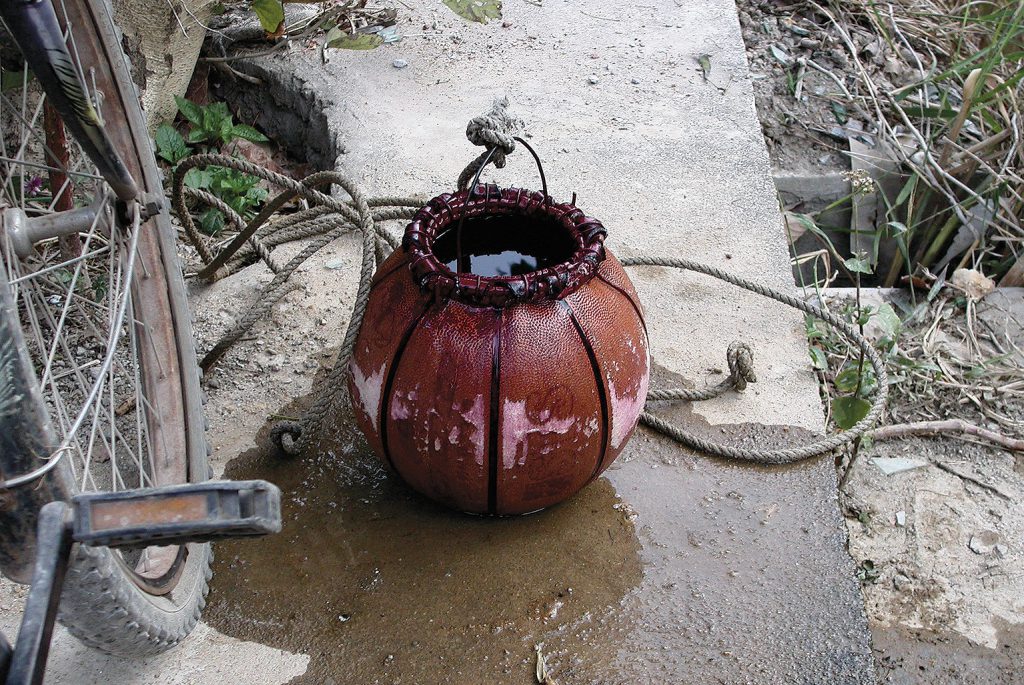
Basketball-Bucket 2011
Image courtesy the Gwangju Biennale Foundation
dogadobisangdo
(design is design is not design)
Gwangju Design Biennale 2011
2 September – 23 October 2011
Gwangju, South Korea
Artistic Directors: Seung H‐Sang and Ai Weiwei
With an almost suffocating sense of winking irony, recently established East Perth ARI Galleria shares its name with one of the city’s most obnoxiously oversized megamalls. One can only hope that the long, tedious hours of gallery invigilation are periodically enlivened by Google Maps mix-ups leading bewildered bargain hunters to descend upon the unassuming gallery. With its roller-shutter door and cambered entrance suspiciously resembling a repurposed garage, Galleria is a far cry from its more mercantile namesake. Nonetheless, it has an ambitious business plan, boasting a concert venue and exhibition space, studios, a bookshop and a ‘food court’ (in reality, a jaffle iron and a juicer). Just one amongst a recent spate of ARIs and small commercial galleries that have opened up in Perth within the last twelve months, Galleria’s tacit, tongue-in-cheek acknowledgement of the inescapable commercial nature of the art world makes it a particularly appropriate venue for David Egan and Reece York’s collaborative exhibition Seria Ludo.
The exhibition’s title is drawn from the motto of the eighteenth century English Society of the Dillettanti, a group of wealthy aesthetes who sought to educate their less fortunate countrymen by collecting and exhibiting Renaissance painting and sculpture. ‘Seria ludo’, roughly translated, means ‘serious matters in a playful vein’. Indeed, the show is refreshingly vibrant and light-hearted, featuring a colour gradient hula-hoop and a gauging rod, done up in glossy red and white enamel and topped with a baseball cap. The centrepiece of the exhibition is Contraposto 2011, a familiar childhood sandpit, the sides of which are adorned with a gaudy pattern of irregular yellow rectangles on a red ground, mimicking the distinctive aesthetic of 1980s Italian design house the Memphis Group. Partially buried within the sandpit is a tuxedo rental, still in the drycleaner’s plastic sheath, creating an obtuse but nevertheless quite literal illustration of the Dillettanti motto.
Beyond its effervescent colour scheme, the exhibition is densely allusive, weaving together a diverse array of art historical references with a pointed commentary on style, commodification and economy in contemporary art. Dig, Set 2011, a dye-sublimation print on polyester, blurs the distinctions between heroic sculpture and department store mannequins. Elsewhere, a small painting, Treasury of Merit 2011, recreates a piece of Renaissance religious art in Fauvist daubs. Its title is a reference to the fifteenth century practice of selling indulgences, whereby, for a sufficient sum, sinners could offset their earthly crimes and be assured of salvation. The implication presumably is that the patronage or purchase of art is a similarly crass shortcut to cultural righteousness.
Many of the rich, historical allusions of the works in the exhibition remain frustratingly oblique. For instance, how many would recognise the repeated use of surf wax in the materials list to be a reference to the etymological myth that the word ‘sincere’ has its roots in art history? This folk etymology supposes dishonest classical sculptors concealed imperfections with wax, hence the word evolved from sine (without) and cera (wax). Egan and York’s repeated use of the substance implies that their observations of contemporary art may not be entirely earnest. Yet, the artists are surely aware of this sense of elusive, withheld knowledge: Both Laugh 2011 is a bolt of canvas, painted and folded to resemble an oversized piece of note paper, bearing some teasingly unreadable message.
The exhibition’s visual appeal encourages further scrutiny, teasing the audience like some fiendish puzzle just waiting to be solved. This sense of mystery is undoubtedly alluring; like any canny salesmen — whether in an art gallery or a shopping mall — Egan and York know that it is our longing to fully possess something either through understanding or ownership that makes any commodity desirable. The economic realities of the art world exist as sly subtext within this exhibition. The inane slogan daubed as text for the work Romeo Oh 2011 — ‘Trends come and go, Italian style lasts forever’ — could be interpreted as a reference to the Memphis Group or to Renaissance religious art, but those in the know will recognise it as advertising on a hoarding outside a luxury car dealership in Perth. In Seria Ludo, crass commercialism and high art collapse in on each other; for those that can read the signs, this show has a sharp satirical sting in its tail.
Andrew Purvis is a writer and artist living in Perth.
